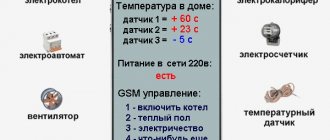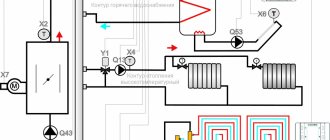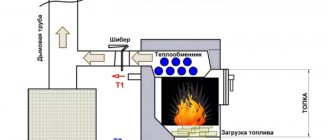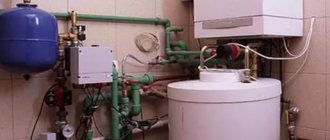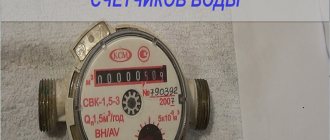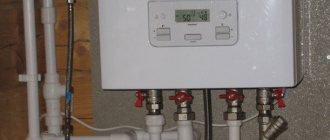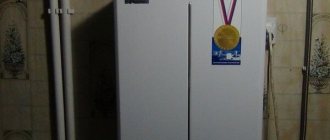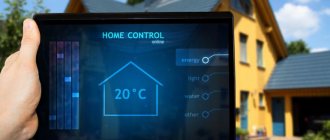Design and principle of operation of the GSM module for the boiler
In essence, the GSM module is a variation of a mobile phone, since it uses the same communication protocol.
The operating principle of the device is as follows:
- using a SIM card, the device connects to the GSM network;
- then it connects to the smartphone;
- You can send a signal to the device from the gadget;
- After receiving the signal, the module changes the boiler settings (raises or lowers the temperature, turns it on, off).
The module itself consists of the following structural elements:
- Thermostat . Controls the boiler temperature and sends a signal to the owner’s smartphone about its change. Many models allow you to use other notification methods (light, sound signals).
- Fasteners . Base for mounting the device. Typically designed for installation on a vertical wall.
- Power unit . The module elements are not designed to work with standard household voltage. Therefore they need a power supply. Typically the operating voltage of the device is 9 V or 12 V.
- Antenna . Allows you to receive signals in the GSM range, with the help of which the module is controlled.
- Sensor _ Determines the temperature of the boiler and transmits the received information to the thermostat for further processing and notification to the owner. Most sensors are capable of operating at temperatures from -50 o C to +99 o C. This allows them to be used in almost any conditions.
- Backup power supply . Represents a battery or accumulator. Designed in case of a power outage or power supply failure. Ensures long-term battery life of the device while maintaining full functionality.
Expert opinion
Grebnev Vadim Savelievich
Heating system installer
Another essential element of the GSM module for boiler control is the SIM card. After all, it is with the help of it that the device connects to the mobile network. But it will have to be purchased separately. Some manufacturers include a SIM card with a suitable tariff in the kit, but this is rare.
Operating modes
Most existing device models have two operating modes:
- Automatic . The owner of the device sets the necessary settings, and the device operates in accordance with them. For example, you can set the boiler to turn off when a certain temperature is reached and turn on again after cooling.
- Manual . In this case, control is carried out completely manually. A smartphone is used for this.
- Anxious . Essentially, this is the same automatic mode. But with one caveat - the system notifies the user in case of emergency situations (for example, an unexpected increase in temperature above permissible values or spontaneous shutdown of the boiler).
Some models allow you to combine modes. For example, you can enable manual control of the boiler and at the same time enable notifications about emergency situations.
Internet or GSM
Remote control of the heating boiler can be done via:
- Internet (mandatory installation of a router and, in fact, an Internet connection will be required);
- heating control in GSM mode (a GSM module with a separate SIM card is required).
Both options are equally comfortable to use; however, the choice may be influenced by the ability to connect to the Internet in a given area and the confidence in receiving the signal of a particular cellular operator.
If possible, it is better to take models with batteries
For places where the network of different operators is available, you can install a GSM heating control unit on two SIM cards of different mobile operators. This will increase the reliability of the equipment. In systems with Internet control there is no such possibility (at least not yet).
When Internet Control is Selected
If you have internet at your dacha or home, you can control the boiler remotely using a Wi-Fi connection. This type of system works without problems with intelligent automation - based on microprocessors/controllers. To work with mechanics, you need to look for special models (one of the domestic ones with a good reputation and not a very high price is “Xital”).
Installation of a heating control system via the Internet
To be able to control the heating boiler remotely, it is necessary to install additional equipment:
- special receiver;
- Remote Control;
- room two-channel (or with a large number of channels) thermostat with a programmer that regulates and sets temperature conditions.
You can program the system while in the house - using the remote control, or from a distance - using a computer or smartphone with an installed mobile application. It can be installed on a smartphone, PC, laptop, tablet. The system in these devices is of any type, the system requirements are extremely low.
“Communication” between the control unit and the shut-off and control equipment occurs wirelessly. That is, during installation, you will not have to connect the unit and thermostats with wires. But you will have to run wires to the temperature sensors - internal and external. They rarely work wirelessly. If you choose to control the boiler via the Internet, allocating an IP address is rarely required.
For control, you can use any mobile device or personal computer with Internet access
The possibilities for controlling a gas heating boiler via the Internet are quite extensive. This:
- remotely set temperature in the house via SMS;
- remote adjustment of the functioning of both the gas boiler itself (and any boiler with a controller) and the circulation pump;
- the ability to change temperatures for individual zones (the number of zones depends on the location of the sensors);
- remote control of the operation of hot water supply systems (double-circuit boilers);
- possibility of remote monitoring of heating status;
- the possibility of energy saving - while you are away from home, you can set the temperature to, say, +8°C, and an hour or two before returning, give the command to increase it to +23°C.
This is the “core set” of capabilities. You can find an improved version with an Internet gateway, which makes it possible to remotely control some of the auxiliary devices: electric convectors, oil radiators, etc. Some models also allow you to connect fire protection systems, which is most important for owners of wooden houses.
Mobile GSM control
To establish remote control of the heating system, a convenient device is used - a GSM module. One or two SIM cards with different (and, preferably, new numbers) are installed in it. Two numbers are a good solution in conditions where there is coverage from two mobile operators, but the signal is not strong enough.
GSM heating boiler control is possible using SMS
Jiesem heating module is an alternative option for remote control of a gas boiler via the Internet. Turning on and controlling the heating temperature via SMS has its advantages:
- compactness of the device (small unit in the house and a smartphone);
- mobility - the ability to install in any place convenient for you;
- ease of use;
- the ability to use two different networks from two different mobile operators for communication simultaneously (models for two SIM cards).
In order for the phone to turn into a kind of remote control, which is part of the “smart home” system, you will need to install a special mobile application. They are available for devices running on the following base:
- Android;
- Windows Phone;
- iOS.
GSM heating boiler control works with units controlled by a controller.
The application is easy to install and configure. Depending on the user settings, the user will receive data from the GSM module in the form of SMS or voice messages. At the same time, it is possible to set up such control from your phone through a cloud service. Specific recommendations and configuration options are in the description and they may have some differences between different manufacturers.
What boilers does it work with?
Before purchasing a module, you need to find out whether the heating boiler supports the connection of such a device. Not all models have such support.
Autonomous systems with forced circulation of coolant (that is, equipped with a pump) are suitable for connecting the device. In this case, it is necessary to rework the safety system in order to prevent breakthroughs at the points where the module is connected.
Expert opinion
Grebnev Vadim Savelievich
Heating system installer
If the module has an air temperature sensor, then it can be used with other types of boilers. However, due to measuring t outside the system, it will work a little less accurately.
Features of operation in various types of boilers
The device has specific operation in different types of heating systems:
- When used in electric boilers, voltage monitoring is possible. The device can also signal a short circuit.
- When used with several boilers at the same time, the device can summarize information from them. This is relevant when used in production or in utility rooms.
- In pellet boilers using wood pellets, the module can regulate the fuel supply to the system.
What are the advantages of GSM boiler control?
Benefits from purchasing the module:
- continuous autonomous operation of the system;
- there is no need to be constantly present at home;
- stable and economical thermal regime;
- access of random people to the control system is excluded;
- instant information about the situation and current parameters of the boiler;
- the ability to predict situations based on daily analysis of the system’s operation.
In cases of deviations and malfunctions of the heating system, SMS messages are sent to the phone, and in the event of a gas leak or power outage, the boiler automatically turns off.
Device usage options
Remote control of a gas boiler via telephone is not only comfortable, but convenient and profitable:
- For example, there is no need to keep the house warm when no one is there. You can turn on the heating by phone from anywhere and at any time. The house will already be warmed up by the time you arrive.
- At any time you can find out what the current temperature is in the house. We sent an SMS request and immediately received a response.
- Suppose your house is located in a village, and suddenly the electricity supply there is cut off. You instantly receive a message from the module about the current situation. You have the opportunity to take the necessary measures to avoid financial losses and other unpleasant consequences that may be caused by a boiler shutdown.
- If you need to leave the house for several weeks in winter, set the lower and upper temperature limits. The system will constantly monitor this range, adjusting the heat supply.
When is a module needed?
A GSM module for controlling the boiler is required when the owner of the house is away for a long time, provided that it is necessary to maintain a certain temperature or turn on the heating in a timely manner.
The most common situations where this is necessary include the following:
- Long departure . The owner of the house goes on a business trip or vacation. In this case, you cannot completely turn off the heating - the system will freeze. At the same time, there is no one to operate the boiler at home.
- Cottage with heating system . If a heating system is installed in a country house, then when the boiler is turned off during the cold season, it will freeze. To prevent this, you can drain the system. But then it will be impossible to come to the dacha in winter because of the cold in the house. The solution to the problem is to remotely maintain a low positive temperature to prevent freezing using a GSM module.
Advantages and disadvantages of GSM devices
This is what the client will receive by connecting the GSM module:
Safety . The main purpose of the GSM module is to control the heating system and additional equipment, timely informing about existing or possible breakdowns. By connecting, for example, an additional broken glass sensor, you can quickly react if thieves break into your house.
Comfort . Management of key indicators of heating and related systems without the physical presence of the consumer next to them. For example, when returning home, you can easily preheat the water in the boiler to the required levels or increase the temperature in the entire house by sending one message.
Saving . When no one is home, the temperature can be as low as possible, and you will thus reduce your heat bill by a significant amount. And the absence of constant load on the heating system will help extend the life of the boiler, boiler and other equipment.
The diagram shows all the benefits of the module that its owner receives. They are implemented through proper device settings and correct connection. (+)
Thanks to these three advantages, the commercial attractiveness of the module is formed.
And GSM equipment also has its drawbacks. Fundamental, of course, is the high price of the device.
Users note the need to constantly monitor the cash balance of cellular communications, dependence on the operator’s work and coverage. This is especially inconvenient for owners of houses outside the city or in villages remote from metropolitan areas.
Additional disadvantages include: the complexity of self-connection and additional installation costs.
How to choose a GSM module
When choosing a GSM module, you should pay attention to the following parameters:
- Ease of management . With a smartphone, everything is clear - the device is controlled using an application. But if the owner of the house, interaction with the device occurs in a different way. There are two most common control methods: physical buttons and touch screen. Models with the second option are more convenient (they show more information about the operation of the heating system). But they cost more. Of course, there are also models that are controlled exclusively from a smartphone. But you shouldn’t buy them - using such devices is not very convenient.
- Equipment . The basic delivery set of the module includes an antenna, an internal temperature sensor, fasteners and the device itself. But there are models with extended equipment. It may include external temperature sensors, gas detectors and other components. The kit is selected based on specific tasks. For example, if the goal is to ensure maximum safety, it is better to choose an option with a gas sensor. And if you just need to control the boiler remotely, the minimum configuration will do.
- Number of channels . The more there are, the more users can control the device. The cheapest models have two channels. But if there are three or four household members, this option is completely unsuitable. Therefore, the more people in the family, the more channels there should be on the module. It should be borne in mind that multi-channel devices will cost more.
- Backup battery capacity . The larger it is, the longer the device can work offline. You need to keep in mind that you should not overpay for a high-capacity battery where it is not needed. It is relevant only in the case when in the locality where the house is located, electricity is often cut off for a long time.
A GSM module for a boiler is a case where the quality of the device directly depends on the price. The higher the cost, the more powerful the processor (which means more settings can be set), the more convenient the control and the richer the equipment. Therefore, saving is always a compromise in relation to the comfort of using the device.
Popular models
GSM alarm Sapsan
GSM modules must be selected depending on the type of boiler equipment and the requirements for the controller.
The most famous models are:
- Xital GSM with modifications 4T, 8T and 12T.
- Sapsan Pro 6 – for any boiler equipment, connection of 10 rooms.
- Telcom 2 – only for De Dietrich, up to 5 numbers.
- Vitocom 100 – only for Viessmann, a maximum of two numbers can be connected.
- Logomatic PRO GSM – only for Buderus, maximum number of numbers – 16 pieces.
READ ALSO: Composition of an automation kit for gas heating boilers
Control system "Xital"
In the market of GSM alarms for heating equipment, the undisputed leader is the Xital system.
This is a powerful, comprehensive remote control system because in many cases it covers not only heating, but also home security.
The module accumulates data on the temperature in the room, pool, pressure in the circuits, collects readings from safety sensors, and simultaneously regulates the room temperature within a given range.
GSM module for boiler Xital 4T
There are several modifications of Xital - GSM-4T, GSM-8T and GSM-12T. They differ in the number of control zones - 4, 8 and 12.
Each device has an analog temperature sensor, as well as five external digital sensors that continuously measure temperature. 30 seconds after the sensors are triggered, Xital will send a message to telephone numbers (you can configure the equipment to turn off when an alarm is triggered).
Users can register up to 10 numbers, including regular landline numbers.
How to connect the module yourself
The algorithm for connecting the module to the boiler is always approximately the same. The model of the device does not matter at all.
To connect the device, you must:
- de-energize the boiler;
- remove the casing;
- connect or solder the module wires to the boiler board in accordance with the instructions;
- install a SIM card, antenna, sensors;
- put back the boiler casing;
- turn on the module and synchronize it with your smartphone;
- restore power supply.
A few important points
On average, about a hundred MB of Internet traffic is required monthly to operate a GSM unit. Errors and interruptions in operation can lead to system failures. Therefore, you should carefully monitor the regularity of payments or connect to a tariff that provides unlimited Internet use.
Another important point is that third-party SMS can negatively affect the operation of the heating system. Therefore, it would be useful to contact the operator and ask to disable all advertising mailings. The best way out of this situation is to buy and use a new SIM card, the number of which no one knows. This will help eliminate a significant part of unformatted SMS, which can cause a failure.
GSM control of the heating boiler via SMS occurs using an application in which you can monitor the status of your heating
There are models that can remotely control a heating boiler both via the Internet and via SMS. Such automation can operate in several modes:
- Auto. A mode in which the GSM heating controller is capable of ensuring the execution of a list of installed programs by analyzing information received from external sensors.
- SMS. When receiving messages sent by the home temperature control sensor via the phone, the controller can reconfigure the heating system in accordance with these parameters.
- Warning. Sending alarm SMS messages to the user in the event of emergency situations (violation of the tightness of water supply systems or gas leaks).
- Providing remote control of other systems and devices, including hot water supply, checking the lighting system, etc.
A very interesting option. Such equipment is more expensive, but makes it possible to choose a more convenient and/or more reliable operation option.
The best models of GSM modules for remote control of heating boilers
Let's look at several current device models available for purchase today.
KotelOK 2.0
A simple, inexpensive and reliable model made in Russia. The cost of the product varies from 5,000 to 6,500 rubles.
Consists of the following components:
- GSM unit with antenna;
- control Panel;
- sensor.
The control panel has a wide monochrome display and four setting buttons. A good GSM antenna provides good signal quality.
The main disadvantage of the device:
- control using SMS commands (no application). This is not very convenient.
The main advantage of KotelOK 2.0:
- possibility of fine adjustment of the temperature of the heating system. It can be changed down to 0.1 o C.
Telemetrics 3
Compact and convenient GSM module. It has a large and most informative monochrome liquid crystal display. Control is carried out using three physical buttons located under the screen.
- The main advantage of the device
Versatility. It can be connected not only to the boiler, but also to any other device (for example, an air conditioner).
- Minus
Lack of complete outdoor antenna. Of course, third-party installation is possible. But these are additional costs. Which are completely inappropriate given the high price of the device (about 9,000 - 10,000 rubles).
Optima-1 Heat monitor
A simple, reliable and easy-to-use device. It consists of a pair of thermostat - GSM module. Able to work with several boilers simultaneously. It is also possible to connect to an alarm system.
Programming is provided for the next seven days for use in automatic mode. There is frost protection, which allows the model to be used in subzero temperatures.
Thanks to the presence of an external antenna in the kit, stable signal reception from the owner’s smartphone is ensured with almost complete absence of interruptions.
- The main disadvantage of the device
Insufficiently informative interface. There is no display here. Instead, indicator LEDs are used. It is clear that it is difficult to reflect all the necessary information with their help.
The cost of the device is from 8,500 to 9,000 rubles.
REMOTE HEATING CONTROL
In order for the Smart Heating system to work accurately and efficiently, it is extremely important to correctly implement remote control. At short distances, special remote controls and radio communications are used, with which you can adjust the heating while being directly in the room or nearby
How to organize heating control over long distances?
To a beginner, such a system may seem very complicated, but in reality everything is quite simple and cheap. So, remote control of heating electrical appliances (convectors, IR heaters, etc.) is implemented using the following components:
- GSM module;
- relay module;
- temperature sensors.
The GSM unit is required to receive commands from the user via a SIM card, which is subsequently installed. The owner of the house sends an SMS message from his mobile phone, which indicates a command to turn it on/off, a request for information or other settings. The module itself, having collected information from other equipment (sensor), can send it to the user.
A relay expander is required to turn on/off the heating appliance after receiving commands from the GSM module, which receives instructions from the user. Some models of relay units allow you to connect several devices at once. There are solutions on sale with a built-in Bluetooth interface, which allows you to control the heating from a smartphone on which the application is installed.
Sensors are needed to monitor the current temperature. They connect to the GSM device, transmitting data. In the event of a sudden change in temperature, information will be sent to the phone, and the owner will be able to choose further actions. Temperature sensors are inexpensive, and many models have additional functions, such as measuring humidity.
A set of components consisting of a relay, a GSM module and a temperature sensor is usually sufficient to organize simple remote control of electrical appliances. Everything here is connected to electricity, in case of a power outage the user will be notified.
Module functions
Opportunities are determined by three factors:
- Number of connected sensors and control channels
- Firmware of the controller, determining the level of control and management.
- Availability of feedback, control of the heating boiler.
Thermometers, pressure or carbon monoxide sensors can be digital or analogue, but the connection is determined by the capabilities of the controller interface. More often, the GSM module is characterized by the connection of analog sensors that produce a certain signal level or change their resistance.
Digital control and data interfaces are almost never used to control a heating boiler, but they allow you to connect equipment such as a security circuit or household appliances that are equipped with an RS-485, RS232 or even USB interface to the device.
As feedback, that is, boiler control, a relay block is used that can simply turn on or off the power of a gas heating boiler or switch modes if the boiler control unit has the appropriate outputs.
In the minimum set, the GSM module is capable of monitoring and transmitting to the user the readings of installed temperature sensors. This is quite enough to know the actual temperature indoors and outdoors and control the heating of the coolant directly in the boiler. Based on these data, it is already possible to judge the quality of the boiler’s operation, determine whether it is working or not, and whether its current installation is sufficient to maintain the set temperature in the room.
A common set of functions is sending an SMS message or calling the user with information:
- On request. The readings of sensors installed in the system are transmitted.
- According to the boundary condition.
In the first case, the user sends an SMS to the number installed in the GSM module with a specific code, or calls and requests the current status of the sensors through voice control. In response, he receives data on the actual value of the sensors by voice or SMS message.
The module independently transmits readings to the user or the established message format if the readings of one or more sensors are outside the set limit. You can set the minimum and maximum allowable value for each sensor, and if the current value is outside the specified range, the user will receive a message about this.
For example, if a temperature sensor is installed directly in the boiler to change the temperature of the coolant, then the limits of the minimum and maximum permissible values are set for it. Let's assume the optimal heating of water is 75°C. Then if the temperature drops below 50°C, it means that an emergency situation has arisen, and for some reason the boiler has stopped heating. It is no longer particularly important what happened, what is important is that the user needs to immediately check the equipment and prevent the home from cooling down.
The extended list of GSM module functions may include the following services:
- Remotely configure set limits and thresholds for sensors.
- Boiler control, on/off, changing the target water temperature.
- Alarm about the presence or absence of electricity.
- Alarm about activation of connected security systems, if the unit is used not only for a heating boiler, but also for an alarm system.
- Advanced boiler control. Based on the value of the installed sensors in the room, in the boiler and outside, the controller, according to a given algorithm, controls the power of the boiler so that, regardless of any weather change, the optimal temperature is maintained in the house.
Modern modifications offer more than just receiving SMS messages. Applications are being developed for mobile devices, such as a tablet or smartphone, that clearly display time schedules, important messages, and the necessary boiler settings. The application automatically requests information from the module on a schedule, for example every hour, to compile detailed and informative statistics.
Criteria for selecting a boiler control module
The key parameters are technical features and functionality:
- control. SMS commands and the touch panel can be used to enter settings. Leading manufacturers' programmers have the ability to quickly control the boiler;
- equipment. In addition to basic elements, the kit may include remote room temperature sensors, equipment that allows you to automatically monitor the level of gas contamination;
- microprocessor. Budget-class products provide a minimum of operating modes and tasks performed. Premium models use weekly programmers;
- number of channels. This indicator determines the number of units that can be connected simultaneously. Simple modules have only 2 channels - for connecting to the programmer and sending SMS messages;
- battery. Power supply is the basis for the operation of the temperature sensor, and in conditions of a power outage it automatically connects to the battery. The battery must have such a capacity that it is enough for many hours of autonomous operation.
The last condition is especially relevant for regions where power outages often occur.
Connection diagram
The GSM module should be installed at a point from where the necessary sensors and interfaces can be connected using the most optimal route. The following should be taken into account:
- The length of the line to the temperature sensor can be from 1 to 100 meters, depending on the functionality of the module.
- The communication line with the boiler for control (feedback) should be as short as possible, especially if the module will switch the power supply to the boiler.
- There must be cellular coverage at the installation site. As an option, an external antenna is used, then the limitation concerns the cable length.
In any case, the most reasonable thing would be to install it directly next to the boiler. But at a minimum distance of at least 1.5 meters and at a height above 50 cm, so that there is no risk of water entering even in the event of an accident.
For convenience or if necessary, the unit is installed outside the boiler room, in a heated room, where there is free access to it for adjustments or observations. Some models are equipped with informative LCD screens, where the parameters of the heating system are clearly visible and it is possible to quickly make changes using a simple navigation menu.
The module is connected to the power supply using a separate power line from the panel and terminal block, or simply to the nearest outlet using a wire and plug. The sensors are connected with wires according to the manufacturer's instructions. In this case, it is important to observe the cross-section of the wire and the material from which it is made. Manufacturers often require the use of coaxial cable to connect sensors with full shielding, especially when the remote sensor is located at a significant distance.
The module often contains a set of terminals with symbols under a protective cover. According to the instructions, color or mnemonic markings are used to determine the terminals for connecting sensors, signal and control wires from the heating boiler.
After the wires are connected and placed in a box or protective corrugated pipe, you can begin setting up. The ranges for the sensors are set, the signal lines are set, and the actions that the control device takes when receiving signals are set.
The main point is to set a telephone number or even two to which the module will transmit readings and from which it will receive settings and commands.
